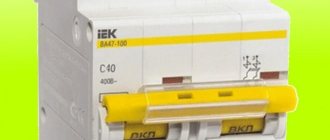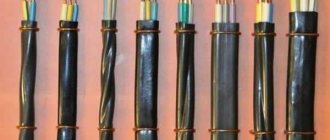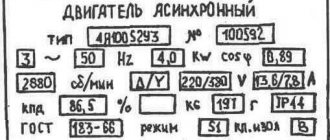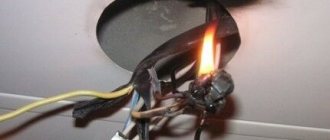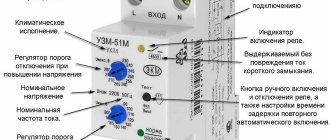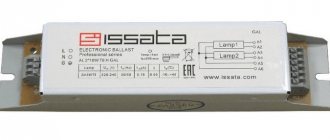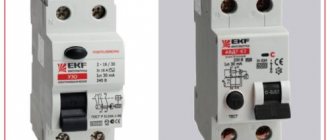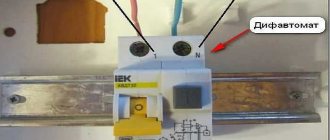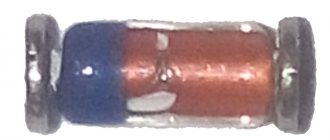How many kW can a machine withstand at 16, 25, 32 and 40 Amps?
When choosing a machine, you need to correctly calculate the load that it can withstand. However, it is equally important to understand that the cable itself must withstand the load from all electrical appliances that are connected to it.
The circuit breaker serves to protect the wiring from fire. The main task of the “machine” is to turn off the power in case of short circuit and overheating of the electrical wiring.
To understand how much a 16, 25 and 32 Ampere machine can withstand, you need to calculate the power and round the value down. You can also use ready-made tables that are given in the article.
How long will a machine withstand 16, 25 and 32 Amps?
For a single-phase network, 1 Ampere equals 220 Watts. In order to find out how much a 16 Ampere machine will withstand, you need to multiply 220 by 16. As a result, we get a value of 3520 Watts. Let's round this value down and get 3.5 kW. This is exactly the load that a 16-amp circuit breaker can withstand.
A 25 Ampere machine will withstand 5.5 kW, and a 32 Ampere machine will withstand exactly 7 kW. Thus, you can quite easily calculate how much any of the circuit breakers, 40, 50 or 63 Amperes, will ultimately withstand.
Earlier in the article: how much a 16 Ampere outlet can withstand, a similar calculation was given. However, it is important to understand that the cable that is connected to the machine must withstand the same load, or better with a small margin, than the machine itself.
Otherwise, if the cable is of insufficient cross-section, the machine will not turn off during overloads, and the insulation of the wire will begin to melt, which will lead to a short circuit in the electrical network.
Purpose
A 25 ampere circuit breaker is a device whose main task is to ensure the safety of the electrical network from overcurrent, that is, from a short circuit with overload. The main purpose of the device is to ensure the safety of the user himself when using the network and electrical appliances.
Such equipment is turned on and off from an electrical circuit. It is most often used to protect an electric stove or other kitchen heating appliances.
You might be interested in How to calculate the inductance of a coil
Note! It can also be used to protect lighting system, motor, transformer and electronic appliance.
Electrical circuit protection as the main purpose
How to calculate the power that a wire can withstand
To calculate the power of a wire, just like circuit breakers, there are ready-made tables. In addition, there is the so-called average current load on the cable, which is calculated as follows: there are 10 Amperes of current per 1 mm² of copper cable.
Therefore, using the following formula, you can approximately calculate the current load and the ability of the cable to withstand it: P = UI power (W) = current (Ampere) voltage (Volt) .
For example, we have an electric stove with a power of 2.5 kW. We substitute the values into the formula 2500W/220V and get 11.3 Amperes . If 1 mm² of copper cable can withstand 10 Amperes, then to connect a 2.5 kW electric stove, you will need a cable with a cross-section of at least 1.5 mm².
And here the main thing is not to overdo it with the load, always remembering that it is not recommended to connect anything else to such a cable other than an electric stove. Again, let’s turn to the calculations and find out how much a 1.5 mm² cable can withstand:
- Copper cable with a cross section of 1.5 mm² - can withstand 3.3 kW load;
- Copper cable with a cross section of 2.5 mm² - can withstand 4.6 kW load;
- Copper cable with a cross section of 4 mm² - can withstand 5.9 kW load;
- Copper cable with a cross section of 6 mm² - can withstand 7.5 kW load;
- Copper cable with a cross-section of 10 mm² can withstand 11 kW of load.
As you can see, there is nothing complicated in calculating the load on the circuit breaker and the cross-section of the wires for connecting it. However, electrical wiring is a rather dangerous element of the electrical network. Therefore, if there are no skills in calculating it or there are any doubts, then it is better not to risk it and invite an experienced electrician.
Technical features
Regardless of how many poles the switch has, the technical parameters of the models remain the same. Thus, the rated voltage, switching parameters and current limiting class will remain unchanged.
Circuit Breaker Specifications Source www.bkpowersystems.com
Healthy! The above values are marked on the body of the circuit breaker. For example, as shown in the photo above.
Rated voltage
The rated electric voltage for the C16 machine is 16 amperes (A). This means that the device is capable of transmitting a current of 16 A (or less) for a long time without overloads or shutdowns.
In this case, possible changes in ambient temperature should be taken into account. So, as the current decreases, the current will increase and vice versa.
Note! The value written on the switch body is applicable for a machine operating at an ambient temperature of 30 °C.
Icn
The concept of switching or rated breaking capacity or Icn means the ability of a device to open the network when a short circuit (short circuit) of a certain strength occurs. Moreover, the C16 automatic circuit breaker, in the event of a short circuit, should not burn out, but completely retain its functional properties, but block the voltage supply.
In most cases, the current value is written on the device body and is indicated by a separate rectangle. Machines intended for domestic use have a value of 4,500 A or 6,000 A.
In models used in industry or commercial environments, indicators are indicated without a rectangular frame. The cost of an S-16 assault rifle depends on its switching capabilities. The higher the indicator, the more expensive the switch will cost.
Interesting! Marking of switches intended for domestic use is carried out in accordance with the international standard IEC 23-3/EN 60898. In fact, according to the contents of the standard, the maximum nominal value of the shutdown parameter is prescribed on the switch.
Current limiting class
The value of this indicator indicates the period of time during which the electric arc is extinguished. The occurrence of the latter occurs as a result of a short circuit.
When a short circuit occurs, the switch opens the contacts and turns off the network. At this moment, the current strength can rise to several thousand amperes. Due to such a huge indicator, an electric arc is formed between the breaking contacts. In addition, she is characterized by a high temperature. As a result of this, the C16 switch is capable of burning out. Because of this, it must be extinguished in a minimum period of time, which occurs due to the arc chute.
Classification according to this criterion divides the device into 3 groups:
- Class 3 - arc extinction is completed in 0.003-0.005 seconds (milliseconds).
- Class 2 - arc extinguishing is completed in 0.005-0.01 seconds.
- Class 1 – arc extinguishing is completed in 0.1 sec.
The current limiting class is applied to the device body in the form of a number 2 or 3 enclosed in a square frame. In most cases, it is written next to the rectangle in which the value of the switching capacity is indicated.
Important! If, when examining the abbreviated markings, you do not find anything similar, this means that the device belongs to the first class category.
Time-current characteristics
Each C16 circuit breaker has 2 releases: thermal and electromagnetic. The first is a bimetal plate, the second is an overcurrent relay.
In fact, these releases automatically open the electrical circuit. This happens in the following way: the bimetallic plate turns off the switch with a prolonged increase in power on a separate branch of the circuit, which is under the protection of this machine. The operation of the electromagnetic release begins only when a short circuit occurs.
However, it is possible that the opening contacts begin to perform the functions of each other. This can happen if the characteristics of the installed circuit breaker do not match the parameters of the electrical network in which it is used.
Interesting! The value of the rated current for activating the releases and the time interval during which the opening occurs is called the time-current characteristic of the C16 machine (VTX).
The marking of the time-current parameters of the breaking contacts is marked with an English letter and is written before the rated current value, in this case it will be indicated as C16. According to GOST R 50345-2010, all 16-amp circuit breakers are classified into 3 groups shown in the table.
Classification of machines according to instantaneous tripping current range Source uk-parkovaya.ru
Connection diagram
The wire feeding the switch is connected to a fixed contact, which is usually located on top. The wire to the power receiver is connected at the bottom. To avoid confusion, a simple diagram indicating the contacts is drawn on the case. They are signed with the numbers 1-input, 2-out. In the three-phase version it is similar: even numbers are supply contacts, odd numbers are outputs.
In modern electrical installations, additional devices are used in conjunction with automatic machines: RCD (residual current device), additional contacts, load switches, automatic switching devices. For reliable operation, it is recommended to install devices of the same series from the same manufacturer.
The choice of manufacturers of protective devices is huge. Domestic enterprises can offer reliable equipment, but the range is extremely narrow. The production of additional devices is very rare. Among foreign companies, ABB stands out, having a serious scientific and technical base. Brands such as Legrand, Siemens, GE, Schneider, Electric, Hager also deserve attention. The choice of equipment should be made for a specific project, looking at the range, which is often limited.
Application of S32 assault rifles
A 32 ampere circuit breaker is installed in residential and administrative buildings. Mixed loads, heating and lighting devices, household appliances and electronics are their main areas of application. They do an excellent job protecting household appliances and electronics. They are used as input - installed before meters, or as protection for individual consumers.
It is not recommended to turn on powerful electric motors through C32 devices, even if they are suitable for the load. The time-current characteristic “C” indicates that the protection may falsely operate due to inrush currents.
Unit conversion rules
In the instructions for many devices there are designations in volt-amperes. Their distinction is necessary only for specialists for whom these nuances are important professionally, but for ordinary consumers this is not so important, because the designations used in this case characterize almost the same thing. As for kilowatt/hour and just kilowatt, these are two different quantities that should not be confused under any circumstances.
To determine electrical power through the network current indicator, you can use various tools with which measurements and calculations are made:
- using a tester;
- using clamp meters;
- making calculations on a calculator;
- using special reference books.
Using a tester, we measure the voltage in the electrical network we are interested in, and then use a current clamp to determine the current strength. Having obtained the necessary indicators and applying the existing formula for calculating direct and alternating current, you can calculate the power. We divide the existing result in watts by 1000 and get the number of kilowatts.
Single phase electrical circuit
Basically, all household electrical networks are single-phase networks that use a voltage of 220 volts. The load marking for them is written in kilowatts, and the current strength is in amperes and is designated as AB.
To convert one unit to another, the formula of Ohm's law is used, which states that power ( P ) is equal to current ( I) multiplied by voltage ( U ). That is, the calculation will look like this:
To summarize how to convert Amps to Kilowatts
Our article turned out to be not as short as many would like. Perhaps someone will even be able to reproach us, saying that it was necessary not to procrastinate, but to immediately say how to convert Amperes to Kilowatts and that’s the end of the matter. In our justification and response, we can only appeal to what we wanted best, that is, to convey to the reader the whole essence of the ongoing processes, and therefore an understanding of what and where it comes from. In this case, if you understand everything, then you will never have to return to our article, because what you understand remains with you forever!
